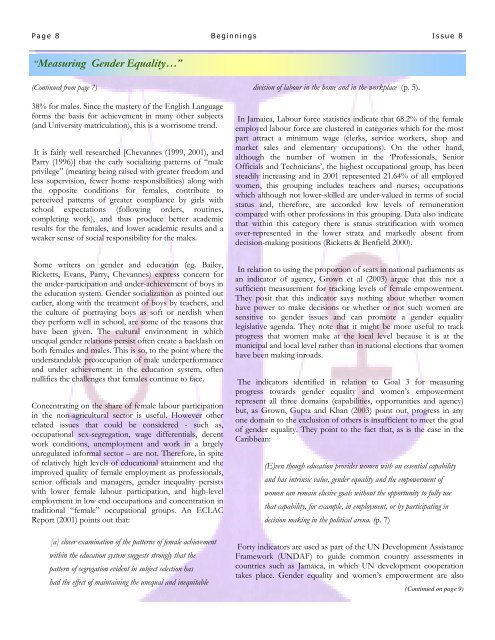Beginnings Issue 8.pub - Planning Institute of Jamaica
Beginnings Issue 8.pub - Planning Institute of Jamaica
Beginnings Issue 8.pub - Planning Institute of Jamaica
Create successful ePaper yourself
Turn your PDF publications into a flip-book with our unique Google optimized e-Paper software.
P a g e 8 B eginnings I s s u e 8<br />
“Measuring Gender Equality…”<br />
(Continued from page 7)<br />
38% for males. Since the mastery <strong>of</strong> the English Language<br />
forms the basis for achievement in many other subjects<br />
(and University matriculation), this is a worrisome trend.<br />
It is fairly well researched [Chevannes (1999, 2001), and<br />
Parry (1996)] that the early socializing patterns <strong>of</strong> “male<br />
privilege” (meaning being raised with greater freedom and<br />
less supervision, fewer home responsibilities) along with<br />
the opposite conditions for females, contribute to<br />
perceived patterns <strong>of</strong> greater compliance by girls with<br />
school expectations (following orders, routines,<br />
completing work), and thus produce better academic<br />
results for the females, and lower academic results and a<br />
weaker sense <strong>of</strong> social responsibility for the males.<br />
Some writers on gender and education (eg. Bailey,<br />
Ricketts, Evans, Parry, Chevannes) express concern for<br />
the under-participation and under-achievement <strong>of</strong> boys in<br />
the education system. Gender socialization as pointed out<br />
earlier, along with the treatment <strong>of</strong> boys by teachers, and<br />
the culture <strong>of</strong> portraying boys as s<strong>of</strong>t or nerdish when<br />
they perform well in school, are some <strong>of</strong> the reasons that<br />
have been given. The cultural environment in which<br />
unequal gender relations persist <strong>of</strong>ten create a backlash on<br />
both females and males. This is so, to the point where the<br />
understandable preoccupation <strong>of</strong> male underperformance<br />
and under achievement in the education system, <strong>of</strong>ten<br />
nullifies the challenges that females continue to face.<br />
Concentrating on the share <strong>of</strong> female labour participation<br />
in the non-agricultural sector is useful. However other<br />
related issues that could be considered - such as,<br />
occupational sex-segregation, wage differentials, decent<br />
work conditions, unemployment and work in a largely<br />
unregulated informal sector – are not. Therefore, in spite<br />
<strong>of</strong> relatively high levels <strong>of</strong> educational attainment and the<br />
improved quality <strong>of</strong> female employment as pr<strong>of</strong>essionals,<br />
senior <strong>of</strong>ficials and managers, gender inequality persists<br />
with lower female labour participation, and high-level<br />
employment in low end occupations and concentration in<br />
traditional “female” occupational groups. An ECLAC<br />
Report (2001) points out that:<br />
[a] closer examination <strong>of</strong> the patterns <strong>of</strong> female achievement<br />
within the education system suggests strongly that the<br />
pattern <strong>of</strong> segregation evident in subject selection has<br />
had the effect <strong>of</strong> maintaining the unequal and inequitable<br />
division <strong>of</strong> labour in the home and in the workplace (p. 5).<br />
In <strong>Jamaica</strong>, Labour force statistics indicate that 68.2% <strong>of</strong> the female<br />
employed labour force are clustered in categories which for the most<br />
part attract a minimum wage (clerks, service workers, shop and<br />
market sales and elementary occupations). On the other hand,<br />
although the number <strong>of</strong> women in the ‘Pr<strong>of</strong>essionals, Senior<br />
Officials and Technicians’, the highest occupational group, has been<br />
steadily increasing and in 2001 represented 21.64% <strong>of</strong> all employed<br />
women, this grouping includes teachers and nurses; occupations<br />
which although not lower-skilled are under-valued in terms <strong>of</strong> social<br />
status and, therefore, are accorded low levels <strong>of</strong> remuneration<br />
compared with other pr<strong>of</strong>essions in this grouping. Data also indicate<br />
that within this category there is status stratification with women<br />
over-represented in the lower strata and markedly absent from<br />
decision-making positions (Ricketts & Benfield 2000).<br />
In relation to using the proportion <strong>of</strong> seats in national parliaments as<br />
an indicator <strong>of</strong> agency, Grown et al (2003) argue that this not a<br />
sufficient measurement for tracking levels <strong>of</strong> female empowerment.<br />
They posit that this indicator says nothing about whether women<br />
have power to make decisions or whether or not such women are<br />
sensitive to gender issues and can promote a gender equality<br />
legislative agenda. They note that it might be more useful to track<br />
progress that women make at the local level because it is at the<br />
municipal and local level rather than in national elections that women<br />
have been making inroads.<br />
The indicators identified in relation to Goal 3 for measuring<br />
progress towards gender equality and women’s empowerment<br />
represent all three domains (capabilities, opportunities and agency)<br />
but, as Grown, Gupta and Khan (2003) point out, progress in any<br />
one domain to the exclusion <strong>of</strong> others is insufficient to meet the goal<br />
<strong>of</strong> gender equality. They point to the fact that, as is the case in the<br />
Caribbean:<br />
(E)ven though education provides women with an essential capability<br />
and has intrinsic value, gender equality and the empowerment <strong>of</strong><br />
women can remain elusive goals without the opportunity to fully use<br />
that capability, for example, in employment, or by participating in<br />
decision making in the political arena. (p. 7)<br />
Forty indicators are used as part <strong>of</strong> the UN Development Assistance<br />
Framework (UNDAF) to guide common country assessments in<br />
countries such as <strong>Jamaica</strong>, in which UN development cooperation<br />
takes place. Gender equality and women’s empowerment are also<br />
(Continued on page 9)

















